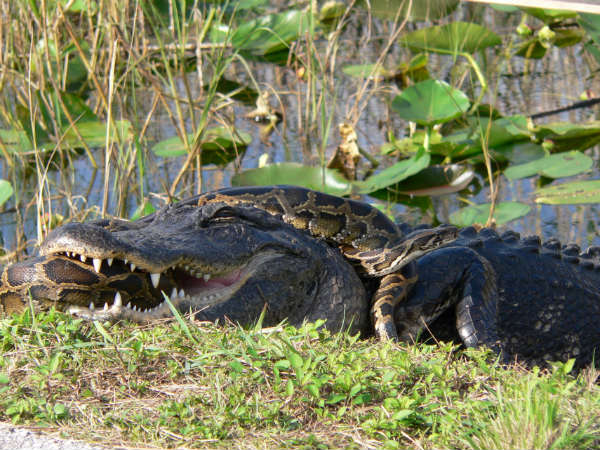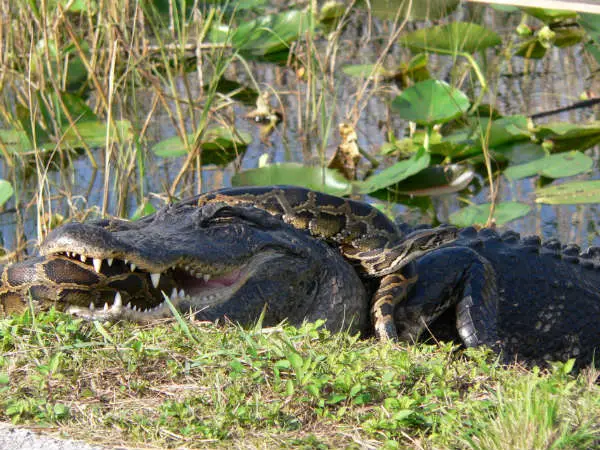Burmese pythons are one of the largest snake species in the world, and they are known for their impressive size and strength. But what exactly do these massive reptiles eat to sustain their massive bodies?
From small rodents to large mammals, Burmese pythons are opportunistic predators who will eat just about anything they can overpower. In this article, we will explore the fascinating world of Burmese python diets, including their favorite prey, hunting tactics, and more. So buckle up and get ready to learn about the incredible eating habits of these impressive snakes!

What Do Burmese Pythons Eat?
Burmese pythons are one of the largest snakes in the world, and they have a huge appetite to match. These massive snakes are native to Southeast Asia, but they have become an invasive species in Florida, where they have been known to eat everything from small rodents to large mammals. In this article, we will explore what Burmese pythons eat and how they go about getting their meals.
1. Small Mammals
Burmese pythons are opportunistic feeders, meaning that they will eat almost anything they can catch. Small mammals, such as rats, mice, and rabbits, are a common prey item for Burmese pythons. These snakes have sharp teeth and powerful jaws that allow them to swallow their prey whole. After catching their prey, Burmese pythons will constrict their prey until it suffocates before swallowing it whole.
Small mammals are not only a nutritious food source for Burmese pythons, but they are also easy to catch. These snakes are ambush predators, meaning that they will wait for their prey to come to them rather than actively hunting them down.
2. Birds
Burmese pythons are also known to eat birds, both small and large. They will take advantage of birds that are nesting on the ground or roosting in trees. These snakes have been known to climb trees in search of prey, and they have even been known to swim in water to catch birds that are resting on the surface.
While birds are not as common of a prey item for Burmese pythons as small mammals, they are still an important part of their diet. Birds are a good source of protein and can provide a larger meal than a small mammal.
3. Reptiles
Burmese pythons are not picky eaters when it comes to other reptiles. They will eat other snakes, lizards, and even turtles. This makes them a threat to native species in areas where they have become invasive.
Burmese pythons are able to eat other reptiles because they have a unique jaw structure that allows them to open their mouths wider than any other snake. This allows them to swallow prey that is larger than their heads.
4. Fish
Burmese pythons are also known to eat fish. They will take advantage of fish that are swimming near the surface of the water or that are stranded in shallow water. These snakes are good swimmers and are able to hold their breath for extended periods of time, allowing them to catch fish underwater.
While fish are not as common of a prey item for Burmese pythons as small mammals or reptiles, they are still an important part of their diet. Fish are a good source of protein and can provide a larger meal than a small mammal.
5. Large Mammals
Burmese pythons are capable of eating large mammals, such as deer and wild pigs. However, these prey items are not as common for Burmese pythons as small mammals or reptiles. In fact, there have been only a few documented cases of Burmese pythons eating large mammals in the wild.
Eating a large mammal requires a lot of energy and can take a long time to digest, which is why Burmese pythons prefer smaller prey items.
6. Benefits of Burmese Pythons
While Burmese pythons are an invasive species in Florida, they do have some benefits. For example, they are excellent hunters and can help control the population of small mammals, which can be a nuisance to farmers and homeowners.
In addition, Burmese pythons are a popular pet, and many people enjoy keeping them as exotic pets. However, it is important to remember that these snakes can grow to be quite large and require a lot of space and care.
7. Vs. Other Snakes
Burmese pythons are often compared to other large snakes, such as anacondas and reticulated pythons. While these snakes have similar diets, there are some differences.
Anacondas are native to South America and are known for their ability to eat large prey items, such as deer and caimans. Reticulated pythons are native to Southeast Asia, like Burmese pythons, and are known for their beautiful patterning.
However, Burmese pythons are the largest snakes of the three and have the widest range of prey items.
8. Predators of Burmese Pythons
While Burmese pythons are apex predators and do not have many natural predators, there are some animals that are known to prey on them. Young Burmese pythons are vulnerable to predators such as birds of prey, crocodiles, and other snakes.
In addition, adult Burmese pythons are sometimes hunted by humans for their skin and meat.
9. Conservation Efforts
Burmese pythons are an invasive species in Florida and are causing damage to the ecosystem. Efforts are being made to control their population, including hunting and trapping programs.
In addition, education and outreach programs are being implemented to help people understand the dangers of releasing exotic pets into the wild.
10. Conclusion
In conclusion, Burmese pythons are opportunistic feeders and will eat almost anything they can catch. Their diet includes small mammals, birds, reptiles, fish, and occasionally large mammals.
While they are an invasive species in Florida, they do have some benefits as excellent hunters and popular exotic pets. However, it is important to remember that they can grow to be quite large and require a lot of space and care.
Efforts are being made to control their population and educate the public about the dangers of releasing exotic pets into the wild.
Frequently Asked Questions
Burmese pythons are one of the largest snakes in the world, and they are known to have a big appetite. However, many people wonder what these enormous reptiles eat in the wild. Here are some frequently asked questions and answers about what Burmese pythons eat.
What do Burmese pythons eat in the wild?
Burmese pythons are carnivores, which means that they eat other animals. In the wild, they are known to eat a variety of prey, including rodents, birds, and other reptiles. They are also capable of eating larger prey, such as deer, pigs, and even alligators.
When hunting, Burmese pythons use their excellent sense of smell to locate their prey. Once they have found a potential meal, they will ambush it by striking with their sharp teeth and coiling around it. They then use their powerful muscles to constrict their prey, suffocating it and preventing it from escaping.
How often do Burmese pythons eat?
Burmese pythons are capable of going for long periods of time without eating. In the wild, they may only eat once every few weeks or even months. However, when they do eat, they consume large meals that can sustain them for a long time.
In captivity, Burmese pythons may be fed more frequently, depending on their size and age. Younger pythons may need to eat more often, while older pythons may only need to eat once every few weeks. It is important to not overfeed captive pythons, as this can lead to obesity and health problems.
Do Burmese pythons ever eat humans?
While Burmese pythons are capable of eating large prey, such as deer and pigs, there have been no confirmed reports of them eating humans in the wild. In fact, Burmese pythons are generally not considered to be a threat to humans, as they are shy and will usually avoid contact with people.
However, there have been instances of captive Burmese pythons attacking and killing their owners. This is most likely due to improper handling and care, as well as the fact that captive pythons may become more aggressive due to stress and lack of space.
Can Burmese pythons eat animals that are larger than them?
Yes, Burmese pythons are capable of eating prey that is larger than themselves. They are able to do this because of their ability to dislocate their jaw and stretch their skin and muscles to accommodate larger prey.
However, it is important to note that consuming prey that is too large can be dangerous for the python. It can cause injury or even death if the prey is too large for the python to swallow or digest properly. For this reason, it is important to only feed Burmese pythons prey that is appropriate for their size and age.
How do Burmese pythons digest their food?
Burmese pythons have a unique digestive system that allows them to consume large meals and digest them slowly over a long period of time. After consuming their prey, they will swallow it whole and then use their strong stomach muscles to crush and break down the food.
The food is then slowly digested over a period of days or even weeks. During this time, the python’s metabolism increases, and its body temperature rises, helping to break down the food more efficiently. Once the food is fully digested, the python will excrete any waste products.
Burmese Python Feeding Rules and Guidelines
In conclusion, Burmese pythons are formidable predators that can eat a wide range of prey. Their diet varies depending on their size and location, but they are known to consume birds, mammals, reptiles, and even large animals like deer and alligators. While they are native to Southeast Asia, Burmese pythons have established themselves in Florida and have become a major ecological threat. Efforts are being made to control their population and mitigate their impact on the local ecosystem. Understanding what Burmese pythons eat is an important step in ensuring the health and balance of the environment they inhabit.


